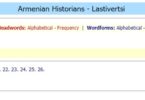Church-State Issues in Cultural Property Law
Prepared remarks of Thomas J. Samuelian
November 2, 2001
The CoE has produced legislative guidelines for cultural heritage laws that summarize the key issues and experience of European countries. Those guidelines, Art. A4.3 The Status of Churches, states:
Concerning the status of Churches, in Europe, there are a number of different approaches to the power of the Church bodies over their own property. A special study of the status of Churches is required bearing in mind the variety of national situations. It must be specified or defined whether the properties of the Churches are bound by the provisions of a general law on heritage or if special laws apply. For example, in Germany, France, and Spain and in the three regions of Belgium, the common heritage law is applied to ecclesiastical items. In the United Kingdom, special provisions apply to ecclesiastical listed buildings so long as they remain in use as places of public worship or associated use. They can be exempted from common heritage supervision if the ecclesiastical bodies concerned have subscribed to a code of practice that has been approved by the national heritage authorities.[1]
The CoE also has a legislative support unit for harmonization of national laws with CoE standards. Currently as the most developed and most relevant set of international standards for Armenia, these guidelines are recommended as a starting point for policy, administrative, and legal reform.
Property rights are based on the general legal framework. Since good laws are the result of good processes of law making that involve the stakeholders in a serious discussion of the needs, goals, and values underpinning the law, I will not be presenting substantive proposals for laws, but rather will be focusing on the criteria for such laws and the process to design and build a consensus for that legal framework. The stakeholders include the church, state, scholars, art and architecture specialists, economic development specialists, tourism companies, pilgrims, worshipers, consumers, the public- at-large, local communities, international organizations, actual and potential donors, public interest groups and NGOs. At the core of the legal framework is the decision making process – the standards and criteria, which are known as “due process.”
Like software code, laws are designed to work on a certain system and to produce certain results. It is not possible to patch together software code designed for different systems or for different functions without causing significant incompatibilities and unexpected results. For this reason, Armenian laws need to be designed for Armenia taking the following into account at a minimum:
- Armenia’s policy goals and the state of Armenian cultural heritage;
- International performance standards;
- Armenia’s current administrative and legal system generally that provides the context within which the cultural heritage laws must operate;
- Localized performance standards;
- Quality control to assure that laws, regulations and administrative structures produce results consistence with (1) and (2) given (3) and (4);
- Debugging of the laws before adoption to eliminate, to the extent possible, unexpected or undesirable results, opportunities for misapplication or corruption of the law.
This report is based upon a review of a number of foreign laws, models, and reports and assessments of legal and administrative frameworks, copies of which are attached as reference material in the appendix. These include surveys by the CoE of European laws and practices and materials from the CIS and former soviet and East European countries.
Since soviet times, Armenian laws have tended to be based on soviet and Russian models. This trend continues with the draft Fundamentals on Culture, circulating during the summer and fall of 2001. This approach has pros and cons. The main advantages are (1) common provenance, making compatibility with the Armenian legal and administrative system and legal culture and practices more likely than laws from other sources, (2) quality control, since these Russian models have been developed for a larger country with more resources for law development. The main disadvantages are that these laws are (1) designed for a multiethnic federation with more resources and many problems and policy objectives that may not be appropriate for Armenia, (2) the Armenian legal and administrative systems and policies are now sufficiently different from the Russian system that compatibility is now a problem, especially since other laws have been adapted in such a way through editing and revision that compatibility is not possible, (3) Russia like Armenia is going through a transition and the laws are a reflection of Russia’s transitional needs and compromises which may not coincide with Armenia’s needs.
Other Foreign Models. Various foreign models, especially European and Baltic models have been reviewed. No set of foreign laws is directly applicable to Armenia, because the local conditions, institutions, and policy goals are different. They may be used as a reference point, but not more. They are not ready-made “software modules” that can be plugged in as patches or slightly modified and expected to run in the Armenian context. While such measures may be justified in the short-term because of the urgent need for regulation or lack of resources, in the longer-term Armenian cultural heritage laws need to be thought through and produced with the performance criteria and policy clarification set forth above.
Of the models reviewed, Cyprus and the Baltics appear to be the most directly applicable. They possess relatively modern laws for countries similar in size, recent history of independence, and ethnic/national composition within CoE framework of standards. The laws of European countries with larger, more diverse populations, federative systems, and longer histories of independent legislative development tend to have unique approaches that are the result of historic compromises that are not applicable to the Armenian context and therefore cannot be directly transposed or would need serious adaptation for the Armenian context.
The Cyprus and Baltic models, however, do not provide much guidance for the unique role of the national church and its large share in cultural heritage. Nor do the laws of Roman Catholic countries where, for the most part, church-state relations were handled differently, nor those of most soviet countries, including Russia, where because of differences in scale and resources and less diffuse diaspora, the Russian Church is in a different situation from the Armenian Church. The countries with national churches, such as England, Denmark, Sweden, Finland, and Greece, provide closer analogies; however, in each case unique historic-cultural factors (e.g., special antiquities laws in Greece, national trust in England), national wealth and size, and the unique course of the development of their legal systems precludes direct application of their policy solutions to the Armenian context.
Performance Criteria, Quality Control, Abuse-Proofing
To help assist in the policy clarification, development of performance and quality control criteria for Armenia’s cultural heritage laws, as well as the debugging and performance testing of those laws, a set of checklists and criteria, need to be developed in light of international standards and unique local needs and situations.
These checklists and criteria can help guide policy makers and legislative drafters, including consultants, in their development of a new generation of cultural heritage laws for Armenia. Serious consideration should be given to including these criteria in “terms of references” for future law development and consulting projects and for internal use by the relevant legislative or government oversight for law development in this field.
Any new law should facilitate the design and execution of certain basic transactions essential in Armenia in an internationally accepted manner:
- Quality Assurance. Assure that all common and essential transactions are easily performed. All essential transactions should be at least as easy and enforceable under the Armenian Law as under the best international practice.
- Test Performance in Context. To ensure this, the draft law should be tested against certain performance criteria taking into account the actual legal framework, institutions and practices in Armenia.
- Abuse Proof. “Abuse proof” the law, that is, for the most typical transactions the provisions of the law must be examined from the point of view of how a less than honest and diligent individual might misuse the law to extract bribes, cause delay or undermine fair and predictable outcome.
Any recommended new law should be accompanied by “proof” or “a written demonstration” that it meets these three criteria.
Due process is the fundamental basis of the rule of law. Due process requires that any state action that affects people’s rights meet certain criteria. Those criteria are designed to assure that the state action promotes a legitimate state interest in the most efficient way possible and with the least burden on the rights of the citizens. This is the international standard to which Armenia has bound itself, e.g., under the International Covenant on Economic, Civil and Political Rights, Art. 4:
The States Parties to the present Covenant recognize that, in the enjoyment of those rights provided by the State in conformity with the present Covenant, the State may subject such rights only to such limitations as are determined by the law only in so far as this may be compatible with the nature of these rights and solely for the purpose of promoting the general welfare in a democratic society.
On both a practical and theoretical level international experience has shown that the following are essential for due process:
- Notice/Petition – People need to know what state actions are being proposed before they are enacted. People also need to have a way to propose state actions. Notice can be given by publishing a list of such proposals, e.g., on an internet site, along with a deadline for comments. Petition rights can similarly be afforded by designating an office where proposals and recommendations can be made.
- Opportunity to be heard – Once a proposal is made, the proposal needs to be discussed publicly. In particular, the people who will directly be affected by the proposal need to explain why it is good or bad for them. This is an essential ingredient for quality assurance in law-making. No law- or decision-maker can possibly foresee all the implications of a proposed state action. Opportunity to be heard can be effected through public hearings or written submissions that are published or publicly available. Once again, an internet site could be an inexpensive way to provide an opportunity to post comments and make them part of the public record.
- Standard of decision – The proposal should be adopted only if it bears a rational relationship to a legitimate state interest. The end must be legitimate and the means must be well-suited to achieve that end without unnecessarily restricting citizen’s freedom and rights and without imposing a burden that outweighs the good to be achieved. State choices need to be reasoned, like judicial opinions. The application of a standard is a discipline to prevent bad laws and regulations from being adopted and to provide a basis for later review and ICECPR, Art. 4, quoted above, gives an international standard for any law, regulation or decision.
- Review – No one is perfect. Circumstances change. Any law or decision must be subject to review or reconsideration to correct problems with the law itself and to correct faulty applications of the law. This is usually done through administrative proceedings at ministries, or through the courts.
Justice and the rule of law are not static objects. They are processes. No law, regulation or decision can foresee every situation. But there is a better chance that it will cover most needs and foreseeable situations if it is reviewed from a number of different perspectives. The role of the state in law- and decision-making is to create a process that will produce good state actions. Good laws and good decisions are an essential duty that a society owes itself. No one can do this for the society. The four steps above are the cornerstones of the rule of law.
E-Governance as a Means for Institutionalizing Due Process
The essence of the rule of law is due process and equal protection. Due process requires (1) notice, (2) an opportunity to be heard, (3) rational/reasoned decision making, and (4) meaningful appeal. Equal protection requires consistent application of rules and equal access, both of which are grounded in access to information. The legal and administrative framework has proved to be one of the most intractable impediments to economic development in many emerging markets, including post-soviet countries like Armenia. E-governance empowers individuals, attorneys, and public interest groups by promoting transparency, equal access to information, and meaningful opportunities to engage the legal and administrative system in a system-changing way. E-governance provides non-controversial measures so that public and private sectors can work to develop together, fostering confidence while making a concrete contribution to developing the tools and processes required for a sustainable business climate and good governance.
The Church as the Largest Owner of Armenian Cultural Property
The largest single category of immovable cultural property in Armenia and around the world are churches and church-related property. The transfer of church property to the Church is underway, but there remain a number of issues regarding the methods of oversight and legal documentation of those transfers that can cause friction between church and state and give rise to unnecessary entanglement between church and state in the management of properties once they are transferred to the Church.
Within the CoE there are a number of countries that have national churches with long histories. In England, for example, most churches and immovable cultural property belong to the church, and churches actively used for worship are largely exempt from state oversight except in the most extreme situations and are supported by the quasi- public English Heritage endowment. Denmark and Greece, where the church is granted special status in the Constitution, the state has a more active role in the financing and preservation of church properties. Sweden has an Endowment Fund and manages church property on a diocesan basis through a church tax. Finland also has a church tax collected by the state to support the church.
Given that Armenia’s tax base is currently, and likely to remain for the foreseeable future, too small to expect state support for the church and since the largest potential support for church properties and cultural heritage is outside of the state and the state’s taxing power, the English model may warrant closer examination for Armenia’s situation. The situation in Roman Catholic countries, such as France, Italy and Spain, has been shaped by the unique relationship between an international/supernational church and the local states, and is not directly relevant to the situation of the Armenian Church in Armenia. On the other hand, the relationship between the Armenian Church and foreign states is quite analogous to that of the Roman Catholic church and may provide insight into the manner in which the Armenian Church handles cultural heritage issues outside of Armenia, recognizing that in each country it will need to have a policy tailored to the local laws and customs, and especially recognizing that the cultural heritage policies of its nearest neighbors may be hostile to preservation of Armenia’s cultural heritage.
Church-State Relations
As a country and culture with a prominent national church, Armenia faces certain unique issues that require unique solutions. While none of the international treaties, or the US Constitution, which is usually cited as the source of the doctrine of separation of church and state, use the term “separation of church and state,” the international norm is usually referred to as separation of church and state. Cultural heritage laws, particularly in Europe and Russia, place cultural property under dual jurisdiction. State/church oversight, ownership and financing lead to entanglement and friction between church and state that the doctrine of separation of church and state aims to avoid.
There are a number of approaches that work in various countries. There is no exact analog to the Armenian situation; therefore, at best these models can serve as points of reference for the development of a policy and legal framework for Armenian law and policy in this field. In particular, England, Denmark, Sweden, and Greece, have found working models for their national church properties, with the English model granting the most independence to the church, since the church is the largest holder of immovable cultural property. “Scandinavia is the only part of Europe with special laws for the Established Church (in the United Kingdom there are special provisions as part of general law). One section of Sweden’s heritage protection law is devoted to the ecclesiastical heritage, and specific laws on Established Church property exist in Denmark, Norway and Finland. A distinctive feature of this special legislation is that it only applies to the Established Lutheran Church, and does not apply to other religious communities, event Christian ones.”[2]
In other countries, particularly Roman Catholic countries, there is greater state control over church properties, which is based at least in part upon significant state support through tax revenues for church properties and church activities generally, which is not likely in Armenia for the foreseeable future. Since these relationships have developed out of unique cultural and historical contexts and sustained pro-national church policies of those states, they are not likely to be directly applicable to Armenia, because of the soviet and tsarist past. In any event, adopting or grafting principles from one system onto another can cause harm or at a minimum less than optimal results.
Which approach is best for Armenia will need to be determined by the stakeholders and may evolve in time, as the Armenian Church recovers from the past several centuries of persecution and repression. The return of church properties, in particular immovables, to the church is an important component in the recovery of the church and in the redress of the state repression against the church in the soviet and tsarist era. This principle of return of state property was adopted in the Church-State Memorandum signed on March 17, 2000 as the framework for the relationship between church and state which has entered a new stage with the 1700th celebrations. The Memorandum placed high priority on the issue of church property, placing it second on its agenda, Art. 1(b) “clarifying the problems related to the property of the Holy Armenian Apostolic church as a juridical body (land, real and movable property, historical cultural monuments, etc.” Since early 2000, a church-state committee has been working on a more formal and detailed document, but this process appears to have stalled.
The current process for addressing issues of ownership or maintenance/adaptation of immovable church property involves a series of applications and referrals through up to 10 governmental agencies: a request from the local church to the Diocese, to Etchmiadzin, to the State Commission on Religious Affairs, to the Historical Monument Preservation Administration at the Ministry of Culture, to the Ministry of State Property and then the Government, and may also include the City Architect at the Mayor’s office or Province Administration Office, the State Cadastre (central and/or local) and the Ministry of Civil Construction. This process is very burdensome and inefficient and may cause delays and inconsistent applications of law and policy that may endanger or impede effective preservation or use.
In the meantime, the Government has passed resolutions to return church properties, but the actual return has been complicated in a number of places by defects in land surveys, land titles, and cultural heritage oversight processes.
Use of these buildings as community spiritual centers and houses of worship is consistent with the original use of the immovables and also with the needs of the church and community and the goals of preservation, since preservation is best promoted and sustained by a community that cares for the immovable financially and otherwise.
One urgent issue that has not been resolved is adaptation to current needs. In this regard, the state administration and legal culture is still in transition. On the one hand, the church has not yet recovered sufficiently to maintain its own historical and cultural preservation department and on the other the state and its secular specialists have not been able to overcome the soviet legal culture and antipathy toward religion and believers.
In the meantime, because of scarce resources, neither Church nor State are in a position to do the necessary maintenance, putting Armenia’s immovable heritage at risk. As between them, however, the Church is in a better position to gather funds from the diaspora than the state treasury, because of international tax and charitable giving laws and the Church’s worldwide network of institutions and foundations, as well as doubts and suspicion of diasporans and donors about the accountability and transparency of funds donated or granted to the state.
Finally, much of Armenia’s extraterritorial heritage is church-related, and under international and most national laws, church and private property have various protections that a foreign sovereign cannot provide. Therefore, one conservation measure would be to gather such properties in church and private hands in concert with RA diplomatic action within the CoE and UNESCO cultural heritage protection frameworks. However, the effectiveness of these measures would be weakened if the Church in Armenia does not play a similarly prominent role in maintenance and control of immovable cultural property.
Under the circumstances, this effort to disentangle the Church from the State is the best option for preserving cultural heritage with the State supporting the Church and the Church taking the lead with substantial independence, provided it has the capacity, financial and expertise, to manage and protect the properties.
Recommendations on Church-State Relations:
- Present and former Church properties need to be inventoried, assessed for risk, and prioritized for maintenance, preservation, and reactivation.
- Urgent attention needs to be paid to monitoring churches to prevent vandalism, pilfering, inappropriate tourism, enforcement of protection zones to assure that inappropriate building or activities, noise, bazaars, picnic areas, restaurants, hotels, amusement parks, do not encroach on the sanctity of the church grounds.
- The Church needs to develop its own capacity, including financial, management, and technical expertise, to manage these cultural properties, e.g., Church Property Trust Fund.
- The Church needs to develop a transparent, objective and accountable system and criteria for the preservation, adaptation and use of cultural properties; e.g., Preservation Codes, self-regulatory mechanisms, independent boards of experts including lay and clergy experts and specialists, long and short-term policy and strategy papers.
- Consistent with the principle of separation of church and state, the legal system should provide for the least interference by the State in Church (as well as other private) cultural property consistent with the state and national interest in its preservation, and should in general defer to the Church’s and private owner’s use of property, provided that the state acting in the national interest can intervene in the case of imminent danger to the cultural property.
- A comprehensive Church-State-Diaspora international policy for preservation of church properties, analyzing rights under international and national laws, fostering ties with other religious and cultural protection organizations, actively participating in the CoE and UNESCO frameworks to advocate for preservation of Armenian cultural heritage, setting an example in Armenia of cultural heritage protection as grounds for reciprocity (e.g., the Blue Mosque in Yerevan and St. Tatei Vank in Iran).
- Create a model of Church management of cultural heritage protection in Armenia toward Armenian cultural heritage that can serve as a precedent to request similar treatment of Armenian cultural heritage abroad.
- Until a Church-based system of preservation and maintenance is established, take steps to reduce bureaucracy and increase efficiency, transparency and due process to raise the confidence of sponsors and funding sources and secure adequate financing for protection of cultural property.
[1] CoE Guidance on the development of legislation and administration systems in the field of cultural heritage, (Strassbourg: CoE Publishing, 2000).
[2] Analysis of national policies on cultural heritage: Report on cultural heritage policies in Europe (Strasbourg 1996).







